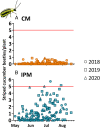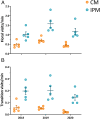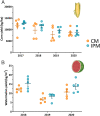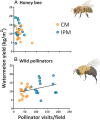IPM reduces insecticide applications by 95% while maintaining or enhancing crop yields through wild pollinator conservation
- PMID: 34697238
- PMCID: PMC8612243
- DOI: 10.1073/pnas.2108429118
IPM reduces insecticide applications by 95% while maintaining or enhancing crop yields through wild pollinator conservation
Abstract
Pest management practices in modern industrial agriculture have increasingly relied on insurance-based insecticides such as seed treatments that are poorly correlated with pest density or crop damage. This approach, combined with high invertebrate toxicity for newer products like neonicotinoids, makes it challenging to conserve beneficial insects and the services that they provide. We used a 4-y experiment using commercial-scale fields replicated across multiple sites in the midwestern United States to evaluate the consequences of adopting integrated pest management (IPM) using pest thresholds compared with standard conventional management (CM). To do so, we employed a systems approach that integrated coproduction of a regionally dominant row crop (corn) with a pollinator-dependent specialty crop (watermelon). Pest populations, pollination rates, crop yields, and system profitability were measured. Despite higher pest densities and/or damage in both crops, IPM-managed pests rarely reached economic thresholds, resulting in 95% lower insecticide use (97 versus 4 treatments in CM and IPM, respectively, across all sites, crops, and years). In IPM corn, the absence of a neonicotinoid seed treatment had no impact on yields, whereas IPM watermelon experienced a 129% increase in flower visitation rate by pollinators, resulting in 26% higher yields. The pollinator-enhancement effect under IPM management was mediated entirely by wild bees; foraging by managed honey bees was unaffected by treatments and, overall, did not correlate with crop yield. This proof-of-concept experiment mimicking on-farm practices illustrates that cropping systems in major agricultural commodities can be redesigned via IPM to exploit ecosystem services without compromising, and in some cases increasing, yields.
Keywords: crop pollination; ecological intensification; integrated pest management; neonicotinoid seed treatments.
Copyright © 2021 the Author(s). Published by PNAS.
Conflict of interest statement
The authors declare no competing interest.
Figures




Comment in
-
Integrated pest management can still deliver on its promise, with help from the bees.Proc Natl Acad Sci U S A. 2021 Nov 30;118(48):e2118532118. doi: 10.1073/pnas.2118532118. Proc Natl Acad Sci U S A. 2021. PMID: 34819382 Free PMC article. No abstract available.
Similar articles
-
Plant versus pollinator protection: balancing pest management against floral contamination for insecticide use in Midwestern US cucurbits.J Econ Entomol. 2025 Feb 11;118(1):262-273. doi: 10.1093/jee/toae202. J Econ Entomol. 2025. PMID: 39278632 Free PMC article.
-
Early-season plant cover supports more effective pest control than insecticide applications.Ecol Appl. 2022 Jul;32(5):e2598. doi: 10.1002/eap.2598. Epub 2022 May 30. Ecol Appl. 2022. PMID: 35343024
-
Implementing IPM in crop management simultaneously improves the health of managed bees and enhances the diversity of wild pollinator communities.Sci Rep. 2023 Jul 7;13(1):11033. doi: 10.1038/s41598-023-38053-5. Sci Rep. 2023. PMID: 37420024 Free PMC article.
-
Towards integrated pest and pollinator management in tropical crops.Curr Opin Insect Sci. 2022 Apr;50:100866. doi: 10.1016/j.cois.2021.12.006. Epub 2021 Dec 28. Curr Opin Insect Sci. 2022. PMID: 34971783 Review.
-
Delivering Integrated Pest and Pollinator Management (IPPM).Trends Plant Sci. 2020 Jun;25(6):577-589. doi: 10.1016/j.tplants.2020.01.006. Epub 2020 Mar 12. Trends Plant Sci. 2020. PMID: 32407697 Review.
Cited by
-
Short-term persistence of foliar insecticides and fungicides in pumpkin plants and their pollinators.PLoS One. 2025 Apr 2;20(4):e0311634. doi: 10.1371/journal.pone.0311634. eCollection 2025. PLoS One. 2025. PMID: 40173098 Free PMC article.
-
Floral visitation of European honey bees and hoverflies in selected cultivated cucurbitaceous crops in Morogoro, Eastern-Central Tanzania.PLoS One. 2025 May 12;20(5):e0322219. doi: 10.1371/journal.pone.0322219. eCollection 2025. PLoS One. 2025. PMID: 40354430 Free PMC article.
-
Graphene-Delivered Insecticides against Cotton Bollworm.Nanomaterials (Basel). 2022 Aug 9;12(16):2731. doi: 10.3390/nano12162731. Nanomaterials (Basel). 2022. PMID: 36014596 Free PMC article.
-
Tracking sustainability in crop pest management in the United States using an eco-efficiency index.Front Insect Sci. 2025 May 20;5:1582496. doi: 10.3389/finsc.2025.1582496. eCollection 2025. Front Insect Sci. 2025. PMID: 40463889 Free PMC article.
-
One Health, many approaches: integrated vector management strategies support One Health goals.Front Insect Sci. 2025 Jun 3;5:1549348. doi: 10.3389/finsc.2025.1549348. eCollection 2025. Front Insect Sci. 2025. PMID: 40530168 Free PMC article. Review.
References
-
- Stern V. M., Smith R. Y., van den Bosch R., Hagen K. S., The integrated control concept. Hilgardia 29, 81–101 (1959).
-
- Zalucki M. P., Adamson D., Furlong M. J., The future of IPM: Whither or wither? Aust. J. Entomol. 48, 85–96 (2009).
-
- Peterson R. K. D., Higley L. G., Pedigo L. P., Whatever happened to IPM? Am. Entomol. (Lanham Md.) 64, 146–150 (2018).
-
- Sappington T. W., Hesler L. S., Allen K. C., Luttrell R. G., Papiernik S. K., Prevalence of sporadic insect pests of seedling corn and factors affecting risk of infestation. J. Integr. Pest Manag. 9, 1–27 (2018).
Publication types
MeSH terms
Substances
LinkOut - more resources
Full Text Sources

